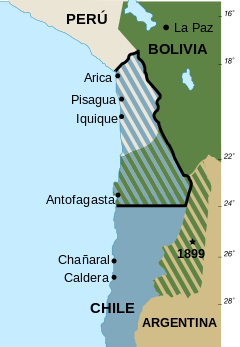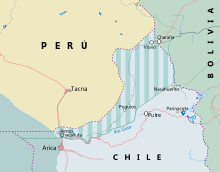Atacama border dispute
The Atacama border dispute is a dispute between Chile and Bolivia that stems from the transfer of the Bolivian Coast and the southern tip of Peru to Chile in the 19th century through the Treaty of Ancón with Peru and the Treaty of Peace and Friendship of 1904 between Chile and Bolivia after the War of the Pacific (1879–1883). The dispute is considered to be ongoing because Bolivia still claims a sovereign access to the Pacific Ocean. The conflict takes its name from the Atacama Desert on which lies the disputed territory. Due to a transfer of land to both Argentina and Chile during the Chilean annexation of the Bolivian coast in 1879, the Puna de Atacama dispute—this spin-off dispute was settled in 1899.

Origins
The origins of the dispute came from the borders established in the Spanish empire that just defined the Atacama desert as the northern border of the General Captaincy of Chile. Bolivian and Chilean historians disagree on whether the territory of Charcas, originally part of the Viceroyalty of Peru, later of the Viceroyalty of the Río de la Plata and ultimately of Bolivia, included access to the sea. Supporting their claims with different documents, Bolivians claim that it did while Chileans disagree. When Simón Bolívar established Bolivia as a nation in 1825, he claimed access to the sea, disregarding overlapping claims by Chile, which had gained independence 7 years before.
The border dispute between Bolivia and Chile grew slowly during most of the 19th century over the Atacama corridor, a part of the Atacama Desert which now forms northern Chile. The Atacama Desert is bordered by the Coast Range on the west and the Andes on the east. The geography of the area was a very large factor in determining how the border dispute began. Because of the mountains, the area has rains only 2 to 4 times a century, making it one of the driest places on Earth.
After the independence of Chile (1818) and Bolivia (1825) none of the following governments of both countries cared about defining its borders. National boundaries in the Atacama region had still not been definitely determined when nitrate, silver and copper deposits were discovered in the area. Both Bolivia and Chile established competing claims for the territory. Other countries' interest was drawn due to the importance of nitrates in the production of fertilizer and high explosives; Britain, Spain and the United States had a strategic and economic stake in controlling the resource granting their support to the different parties. Chile's influence grew in the disputed zone as miners, some of them backed by Chilean and foreign companies, started to advance northwards establishing mines and port facilities. Most economic exploitation of the coastal region was being conducted by Chilean companies and British interests, under the aegis of Chile's more robust economy and more stable institutions.
Boundary Treaty of 1866
National borders in the region had not been clearly agreed until 1866; the two countries had negotiated a treaty[1] that established the 24th parallel south as their boundary, and entitled Bolivia and Chile to share in tax revenue on mineral exports out of the territory between the 23rd and 25th parallels. A second treaty in 1874 superseded this, entitling Bolivia to collect full tax revenue between the 23rd and 24th parallels, but fixed tax rates on Chilean companies for 25 years.[1]
The War of the Pacific
On 27 November 1873 the Antofagasta Nitrate & Railway Company signed a contract with the Bolivian government in which it would have authorized to extract saltpeter duty-free for 25 years. In February 1878, The Bolivian Congress and a National Constituent Assembly found the contract incomplete because it had not been ratified by congress as required by the Bolivian Constitution of 1871. Subsequently, the congress would approve the contract only if the company would pay a 10 cents tax per quintal of mineral extracted.[2][3] Chile claimed that the border treaty of 1874 did not allow for such a tax hike.[4] The company complained the increased payments were illegal. The company mounted significant pressure and demanded that the Chilean government intervene.[5]
When the Antofagasta Nitrate & Railway Company refused to pay, the Bolivian government under President Hilarión Daza threatened to confiscate its property. Chile responded by sending a warship to the area in December 1878. Bolivia announced the seizure and auction of the company on 14 February 1879. Chile, in turn, threatened that such action would render the border treaty null and void. In 1873 Peru and Bolivia had signed a secret Treaty of Mutual Defense.
Shortly after becoming aware of the alliance treaty between Peru and Bolivia, Chile declared war on both countries in April 1879. Within four years Chile defeated the joint war efforts of Bolivia and Peru. It ultimately led to the Chilean annexation of the Peruvian Tarapacá department and Arica province, as well as the Bolivian department of Litoral, leaving Bolivia as a landlocked country.
.jpg)
In 1884, Bolivia signed a truce that gave control to Chile of the entire Bolivian coast, the province of Antofagasta, and its valuable nitrate, copper and other mineral deposits. The two countries signed the Treaty of Peace and Friendship in 1904, which made this arrangement permanent. Chile built a railroad connecting the Bolivian capital of La Paz with the port of Arica and guaranteed freedom of transit for Bolivian commerce through Chilean ports and territory.
Chilean proposal of 1975

In 1975, the Chilean government of Augusto Pinochet made a proposal to Bolivia consisting in a swap of a narrow continuous corridor of Chilean land from the sea to the border between Chile and Bolivia, running parallel to the border between Chile and Peru, making the Lluta River Chile's northern border, in exchange for the same amount of Bolivian territory.[6][7]
The proposal involved former Peruvian land and according to the treaty of Ancón, Chile could not give former Peruvian territories to other nations without Peru's agreement. The dictator of Peru Francisco Morales-Bermúdez was opposed to these changes but proposed to make Arica a territory governed by the three states. Chile responded that it could not accept this complicated shared sovereignty.[7]
Recent history
Bolivia still wishes for an Atacama corridor, which Chile rejects. In spite of this conflict, Chile grants unrestricted access to all kinds of Bolivian merchandise through the Atacama. The territories ceded by Bolivia and Peru contain some of world's largest copper deposits. These are mined by Codelco - a state owned mining company which contributes a significant part of the Chilean state's income.
During the Bolivian Gas War the dispute rose again as most Bolivians, including Evo Morales (who would go on to become president), opposed the future export of Bolivian gas through Chilean territory, which the government and foreign companies wanted. In 2004, the anniversary of the 1904 treaty, Bolivian claims were reignited, and the words gas-for-sea became the slogan of those who opposed exportation. The dispute became evident when the Bolivian president Carlos Mesa engaged in a public spat with the Chilean president Ricardo Lagos in the Organization of American States. Mesa, who was under pressure to speak out on Bolivia's aspirations, put the topic in front of all the presidents of the Americas. The Chilean president reacted by mentioning Bolivia's refusal to have diplomatic relations with Chile, and with this on mind he offered diplomatic relationships between the two countries here and now.[8] The offer was hastily declined by Mesa who was not actually seeking an offer but intended to attract international interest to the situation.
Recently, Bolivian president Evo Morales decided to break off all dialogue with Chile on the maritime issue and declared to pursue the issue in litigation via the international courts. He thus broke an OAS resolution in 2012 when the majority of countries in the OAS encouraged Bolivia to pursue the issue via bilateral dialogue with Chile. Former Chilean President Sebastian Piñera has pleaded with Evo Morales to continue with the dialogue but to no avail. The Bolivian government followed through with its determination to file a case with the International Court of Justice on 24 April 2013. Surprisingly, the case does not challenge the border treaties signed by both countries which Evo Morales has always been against. The basis of the case stems from two bilateral negotiations in the 1970s and 1950s where a sovereign route to the pacific was allegedly promised by Chile but never eventuated. Bolivia argues "the rights of expectations" for their case which is a legal commercial term that's never been used in the ICJ. The memorials process ended in early 2015.[9] In October 2018, the International Court of Justice issued a final and binding decision that Chile was not obliged to negotiate granting Bolivia sea access. [10][11]
References
- Tratado de límites de 1866 entre Bolivia y Chile (in Spanish)
- Retrospectiva del enclaustramiento maritimo. Una vision critica sobre como se inicio el conflicto. Jorge Gumucio. La Paz, Bolivia
- "Archived copy" (PDF). Archived from the original (PDF) on 18 November 2006. Retrieved 31 January 2007.CS1 maint: archived copy as title (link) Relaciones Chile-Bolivia-Peru: La Guerra del Pacifico. June 2004. Patricio Valdivieso. Pontificia Universidad Catolica de Chile
- (in Spanish)http://es.wikisource.org/wiki/Tratado_de_l%C3%ADmites_de_1874_entre_Bolivia_y_Chile
- Los empresarios, la politica y la Guerra del Pacifico. Luis Ortega. Santiago de Chile. 1984. (Page 18. File Antony Gibbs & Sons AGA. Valparaíso to Londres. Private N 25. 6 March 1878)
- Diario La Tercera. "Abrazo de Charaña" (in Spanish). Archived from the original on 23 March 2008. Retrieved 12 March 2008.
Chile y Bolivia restablecen relaciones diplomáticas, después de trece años
- "Evo Morales: Chile offered Bolivia sea access in 1975". BBC News. 29 October 2017. Retrieved 31 October 2017.
- Radio Cooperativa (13 January 2004). "Lagos ofreció a Bolivia reanudar relaciones diplomáticas" (in Spanish). Archived from the original on 24 July 2012. Retrieved 12 March 2008.
Lagos ofreció a Bolivia reanudar relaciones diplomáticas
- "Archived copy" (PDF). Archived from the original (PDF) on 27 December 2013. Retrieved 4 September 2013.CS1 maint: archived copy as title (link)
- "Obligation to Negotiate Access to the Pacific Ocean (Bolivia v. Chile)". Retrieved 1 October 2018.
- "UN court rejects Bolivia's bid for sea access via Chile". Telegraph Media Group Limited 2018. Agence France-Presse. 1 October 2018. Retrieved 1 October 2018.